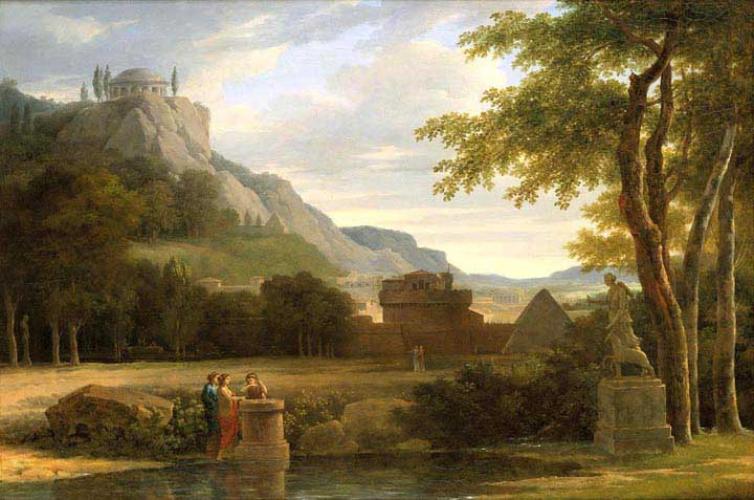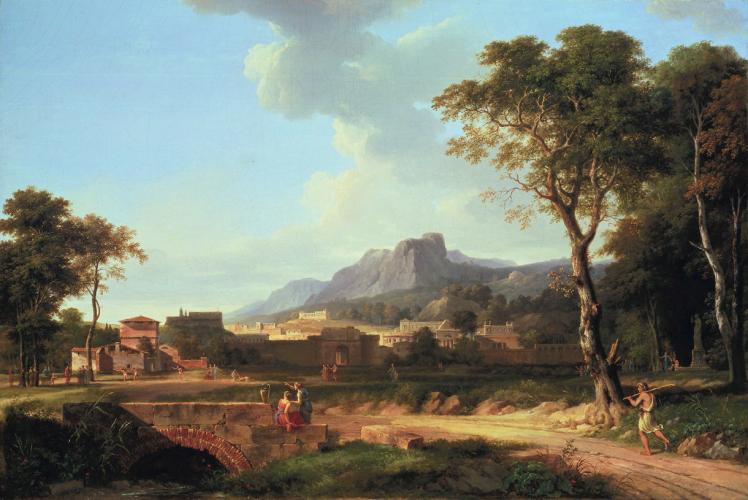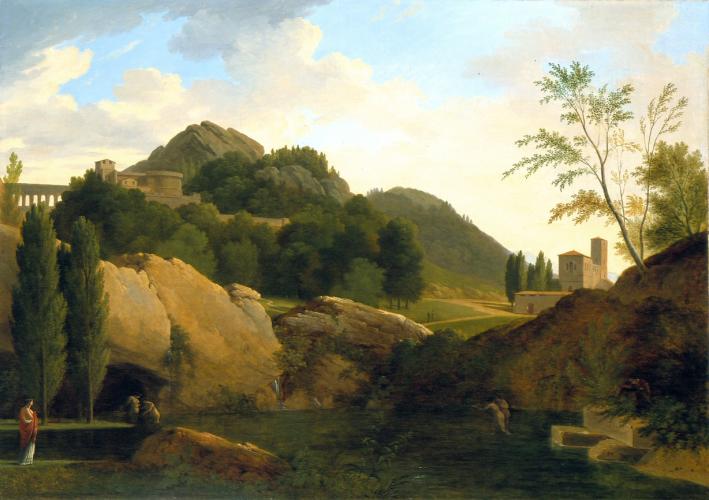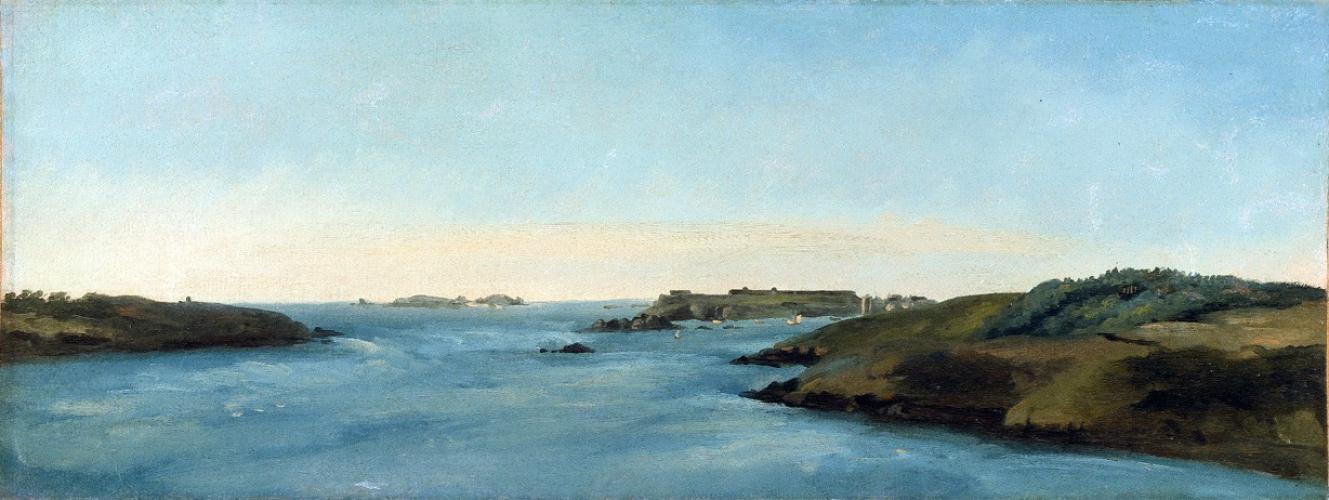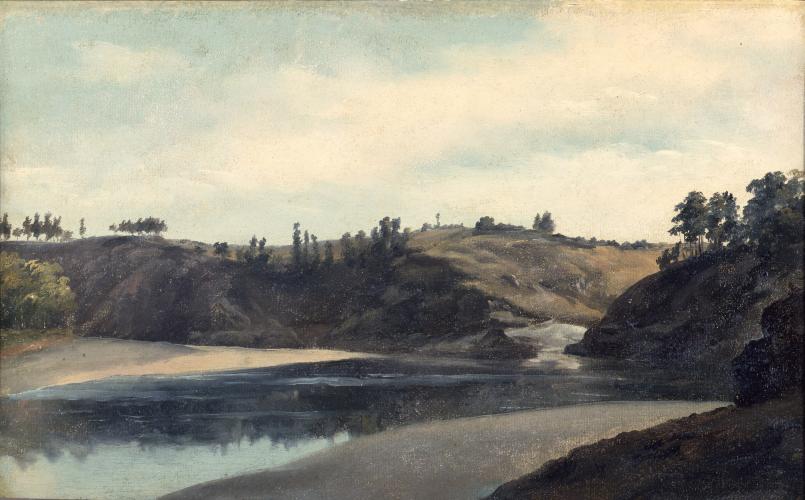Pierre-Henri de Valenciennes
Place Born
ToulousePlace Died
ParisBio
Despite his famous maxim, work in haste, so as to seize Nature as she is,[1] surely a command well understood by the Impressionists, Valenciennes was a forgotten artist within less than a century of his reception at the Academy. Yet the qualities and skills which he so successfully handed down to his pupils in Rome and Paris at the end of the eighteenth century proved to be the key that opened up a wholly novel approach to the art of landscape. Indeed, his legacy transformed not only the traditional view of landscape painting as a lesser genre, but led to it becoming a forum for the most radical artistic experiments.
Valenciennes was born in Toulouse and studied first in the academy there with a minor local history painter, Jean-Baptiste Despax, under whose tutelage he would have become familiar with the iconography of conventional classical and biblical subjects, and the miniaturist Guillaume Gabriel Bouton. Having come to the attention of a Toulouse lawyer and merchant, Matthew Dubourg,[2] Valenciennes was invited to join his new patron and friend on a trip to Rome in 1769, but we know little of his time there. He returned to France in 1771 and arrived in Paris later that year, where he stayed at the home of Rev Monsignor M-J-P Duboug, brother of his earlier patron, entering the Academy schools. His master there was Bouchers old pupil, the history painter Gabriel-François Doyen, with whom he broadened his mastery of traditional subject painting. Four years later he returned to Rome, journeying in the campagna and through the Kingdom of the Two Sicilies; a notebook with thirty-four out of an original forty-five sketches, entitled Journey to Naples, Sicily, Pesti (sic), etc, made in the year 1779 is testimony to his travels there.[3] On this second trip he remained in Italy for four years, dedicating much of his time to the study of perspective under a leading professor of mathematics. Valenciennes later admitted, however, that it was his meeting with Joseph Vernet in 1781 on a trip back to Paris via Switzerland,[4] that transformed the theories he had imbibed in Rome into practical techniques that he could apply as an artist. He later developed this experience into a written treatise, published in 1800, Elemens de Perspective Pratique a l’Usage des Artistes,[5] which proved an essential guide to the two succeeding generations of landscape painters.
Valenciennes had again returned to Rome by 1785 and, two years later, on 28 July 1787, was received at the Royal Academy in Paris. His reception painting was an historical subject set in a landscape, Cicero cutting down the trees which hid the tomb of Archimedes (Paris, Louvre on deposit in Toulouse, Musée des Augustins),[6] a singularly appropriate subject for an artist who had chosen to adapt mathematical formulae to painting. This work was also presented at the Salon that year, along with his Ancient Town of Agrigento (Paris, Louvre), Landscape of Ancient Greece (dated 1786, and now in Detroit, Institute of Fine Arts), and Landscape with an ancient town, and two women offering flowers to the Nayads of a fountain (lost). Although he was already thirty-seven years old there are no surviving dated oil paintings that predate these works. Two years later he presented what might be considered his masterpiece, A Capriccio of Rome with the Finish of a Marathon (San Francisco, Museum of Fine Arts, formerly with Stair Sainty Matthiesen and Matthiesen Fine Art), exhibited at the Salon under the title Landscape Representing an Ancient City (fig. 1). Here the eye is led from the shepherd approaching at the right, his staff over his shoulder, to a bridge on which two young women point to the finish of a race before an imaginary town composed of Roman monuments, in the distance a mountain range is silhouetted against the sky. The artist has carefully modulated the light in conformity with the theories he was to later enunciate in Elemens de Perspective, so that key points in the picture are illuminated by an invisible sun which we may imagine beyond the upper left limits of the composition.
With his reception at the Academy he opened his own studio, being appointed to the new post of Professor of Perspective at the école des Beaux-Arts in 1796 (until 1800). Among his better-known students were Jean-Victor Bertin, Pierre-Athanase Chauvin, Jean-Baptiste Deperthes and Achille-Etna Michallon. Bertin and Michallon in turn were both masters of Corot and it is to the legacy of Valenciennes that Corot owes so much. From the evidence of the oil sketches in the Cröy collection (Paris, Louvre),[7] we know that Valenciennes used his numerous plein-air paintings as the basis of his teaching. While studies such as Grand arbre (Paris, Louvre) were sometimes framed and exhibited, Valenciennes’ treatment of these works was directed towards their use in finished easel paintings. Certainly not the first artist to leave a body of landscape oil sketches done from nature, nor to use them as sources for his grander compositions (the early eighteenth century still life painter and animalier, François Desportes was another), Valenciennes was the first to emphasize the practice of painting such scenes en plein-air as essential to the production of the paysage historique. Even later in the nineteenth century when this genre had been abandoned by all but the most hidebound academics, Valencienness legacy was sustained, the landscape done from nature itself becoming the final product.
While Valenciennes shares with Houel and Hackert the credit for elevating the status of landscape painting, the paysage historique itself was really his invention. A special Prix de Rome was established in 1817 to honor him, giving greater importance to the genre of historical landscape painting (Michallon won the first prize), while the plein-air sketch was championed as an empirical basis for the study of landscape.[8] At the turn of the century he began to lighten his palette, using more oil and a brushier, less polished technique while his approach became more decorative, with fewer historical themes (see fig. 2). Although Valenciennes showed several works at both the 1804 and 1806 Salons he did not exhibit in 1808, presenting only two in 1810 and one, final work in 1814.[9] Just five years after his death in 1819, visitors to the Paris Salon were exposed to the revolutionary work of John Constable, whose View of the Stour near Dedham (1822, now in Pasadena, Huntington Library and Art Collection, fig. 3) was shown at the Salon of 1824. This coincided directly with the move towards naturalism by artists of Corots generation, who looked more to the example of Constable for their large scale finished works than to the tradition of Valenciennes monumental paysage historique. NOTES
[1]Valenciennes, Elemens de Perspective .. under no. Ten, trans. Peter Galassi, Corot in Italy, New Haven and London, 1991, p.66.
[2] 1746-94, probably guillotined in the Revolution. See Pierre-Henri de Valenciennes 1750-1819, Exhibition catalogue, Spoleto festival, Palazzo Racani Arroni, 27 Jun Aug 1996, Una biografia di Pierre-Henri de Valenciennes, Geneviéve Lacambre, p.15.
[3] Paris, Louvre, Cabinet des dessins, RF 12968.
[4] A notebook conserved in the Louvre, Cabinet des dessins, RF 12970, is titled Voyage de Rome à Lion, par Florence, Bologne, Plaisance, Parme, le lac majeur et les îles borromées. Le passage du Simplon, la Suisse jusquà Genéve et le fort de lescluse, etc. Par P. Devalenciennes en 1781.
[5]Elemens de Perspective Pratique a l’Usage des Artistes, suivis de Reflexions et Conseils a un Eleve sur la Peinture, et particulierement sur le genre du Paysage, by P.H. Valenciennes, Paris, Desenne and Duprat, Year VIII (1800), 656 pages, with 36 diagrams and charts.
[6] Cicéron qui fait abattre les arbres qui cachaient le tombeau dArchiméde
[7] This group of 124 oil sketches of landscapes and Italian buildings was part of a larger collection of works bequeathed to the Louvre in 1930 by Princess Louis of Cröy, née Hortense-Eugénie de lEspine (1867-1830), who had inherited the collection of her grandfather, Charles, Marquis de LEspine.
[8] See Paula Rea Radisich “Eighteenth century plein-air Painting and the Sketches of Pierre-Henri de Valenciennes”, The Art Bulletin, March 1982, pp. 98-104; P. Conisbee, “Pre-Romantic plein-air painting”, Art History, vol. 2; Peter Galassi, Corot in Italy, New Haven, 1991.
[9] A group of pictures were shown in 1819 as a posthumous tribute.




